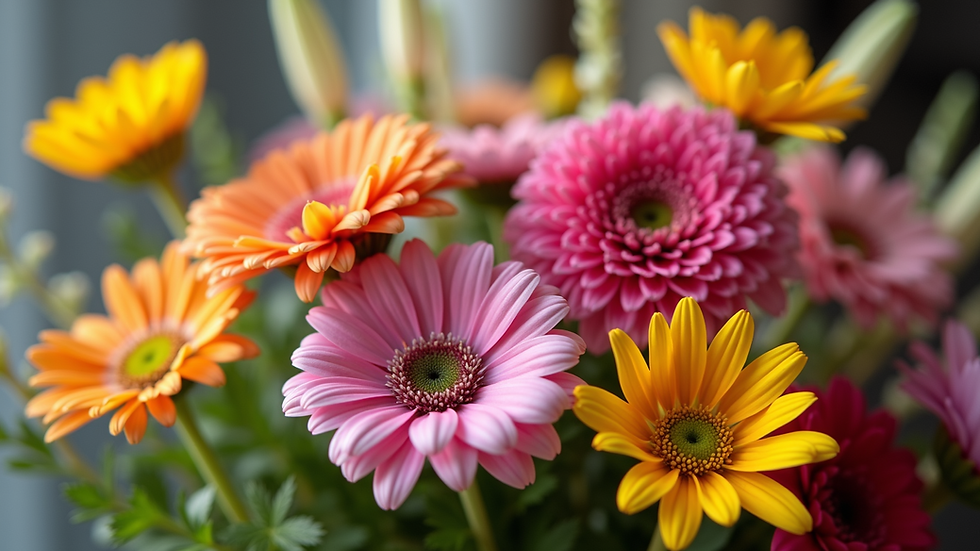Tips for Designing Your Own Custom Bouquet
- Giang Giang
- Aug 8
- 4 min read
Creating a custom bouquet is a wonderful way to express your personality and style through flowers. Whether for a special occasion or just to brighten your home, designing your own bouquet allows you to choose the perfect combination of colors, textures, and scents. This guide will walk you through practical tips to help you craft a stunning and unique floral arrangement that suits your taste and needs.
Understanding the Basics of a Custom Bouquet
Before diving into flower selection, it’s important to understand the fundamentals of bouquet design. A well-balanced bouquet combines different elements such as color, shape, size, and texture. Start by deciding the purpose of your bouquet - is it for a wedding, a gift, or home decoration? This will influence your choices.
Color Palette: Choose a color scheme that complements the occasion or setting. Soft pastels work well for romantic events, while bold, vibrant colors add energy and cheer.
Flower Types: Mix focal flowers (like roses or lilies) with filler flowers (such as baby’s breath or waxflower) and greenery to add depth.
Shape and Size: Decide if you want a round, cascading, or hand-tied bouquet. The size should fit the occasion and the person receiving it.
By mastering these basics, you can create a bouquet that looks professionally designed and feels personal.

How to Choose Flowers for Your Custom Bouquet
Selecting the right flowers is key to a beautiful bouquet. Consider the season, flower availability, and the message you want to convey. Each flower has its own symbolism and meaning, which can add a thoughtful touch to your arrangement.
Seasonal Flowers: Using flowers in season ensures freshness and often better prices. For example, tulips and daffodils in spring, sunflowers and dahlias in summer, chrysanthemums in autumn, and poinsettias in winter.
Flower Meanings: Roses symbolize love, lilies represent purity, and carnations convey admiration. Choose flowers that reflect the sentiment you want to express.
Texture and Contrast: Combine soft petals with spiky or leafy greens to create visual interest. For example, pairing fluffy peonies with sharp eucalyptus leaves.
Don’t hesitate to experiment with unusual flowers or colors to make your bouquet stand out. If you want inspiration or assistance, exploring custom flower bouquets can provide ideas and options tailored to your preferences.

Arranging Your Custom Bouquet
Once you have your flowers, it’s time to arrange them. This step requires some patience and creativity. Here are some tips to help you assemble your bouquet like a pro:
Prepare Your Flowers: Trim stems at an angle and remove any leaves that will be below the waterline to keep the bouquet fresh longer.
Start with Greenery: Create a base by arranging your greenery in a circular pattern. This gives structure and volume.
Add Focal Flowers: Place your largest or most eye-catching flowers evenly throughout the bouquet.
Fill in with Smaller Flowers: Use filler flowers to fill gaps and add texture.
Check Balance and Shape: Rotate the bouquet as you work to ensure it looks good from all angles.
Secure the Stems: Use floral tape or string to hold the bouquet tightly together.
Wrap and Present: Finish with decorative paper or ribbon to enhance the bouquet’s appearance.
Practice makes perfect, so don’t be discouraged if your first attempt isn’t flawless. Each bouquet you create will improve your skills.

Caring for Your Custom Bouquet
To keep your bouquet looking fresh and vibrant, proper care is essential. Here are some simple steps to extend the life of your flowers:
Water: Place the bouquet in a clean vase filled with fresh water immediately after arranging.
Flower Food: Use flower food packets or make your own solution with sugar and vinegar to nourish the flowers.
Trim Stems: Re-cut stems every couple of days to improve water absorption.
Remove Wilting Flowers: Take out any flowers that start to wilt to prevent them from affecting the others.
Keep Cool: Avoid placing the bouquet in direct sunlight or near heat sources.
With these care tips, your custom bouquet will stay beautiful for days, allowing you to enjoy your handiwork longer.
Adding Personal Touches to Your Custom Bouquet
To make your bouquet truly unique, consider adding personal touches that reflect your style or the recipient’s personality. Here are some ideas:
Incorporate Non-Flower Elements: Add ribbons, beads, feathers, or even small charms to the bouquet.
Use Unique Containers: Instead of a traditional vase, try a vintage teapot, mason jar, or a rustic basket.
Choose Scented Flowers: Include fragrant blooms like lavender, gardenias, or jasmine for an aromatic experience.
Match the Theme: Coordinate your bouquet with the event’s theme or color scheme for a cohesive look.
These small details can elevate your bouquet from ordinary to extraordinary, making it a memorable gift or decoration.
Designing your own custom bouquet is a rewarding experience that allows you to showcase creativity and thoughtfulness. Whether you follow these tips step-by-step or add your own flair, the result will be a beautiful floral arrangement that speaks from the heart. For more inspiration and options, explore custom flower bouquets to find the perfect blooms for your next creation.




Comments